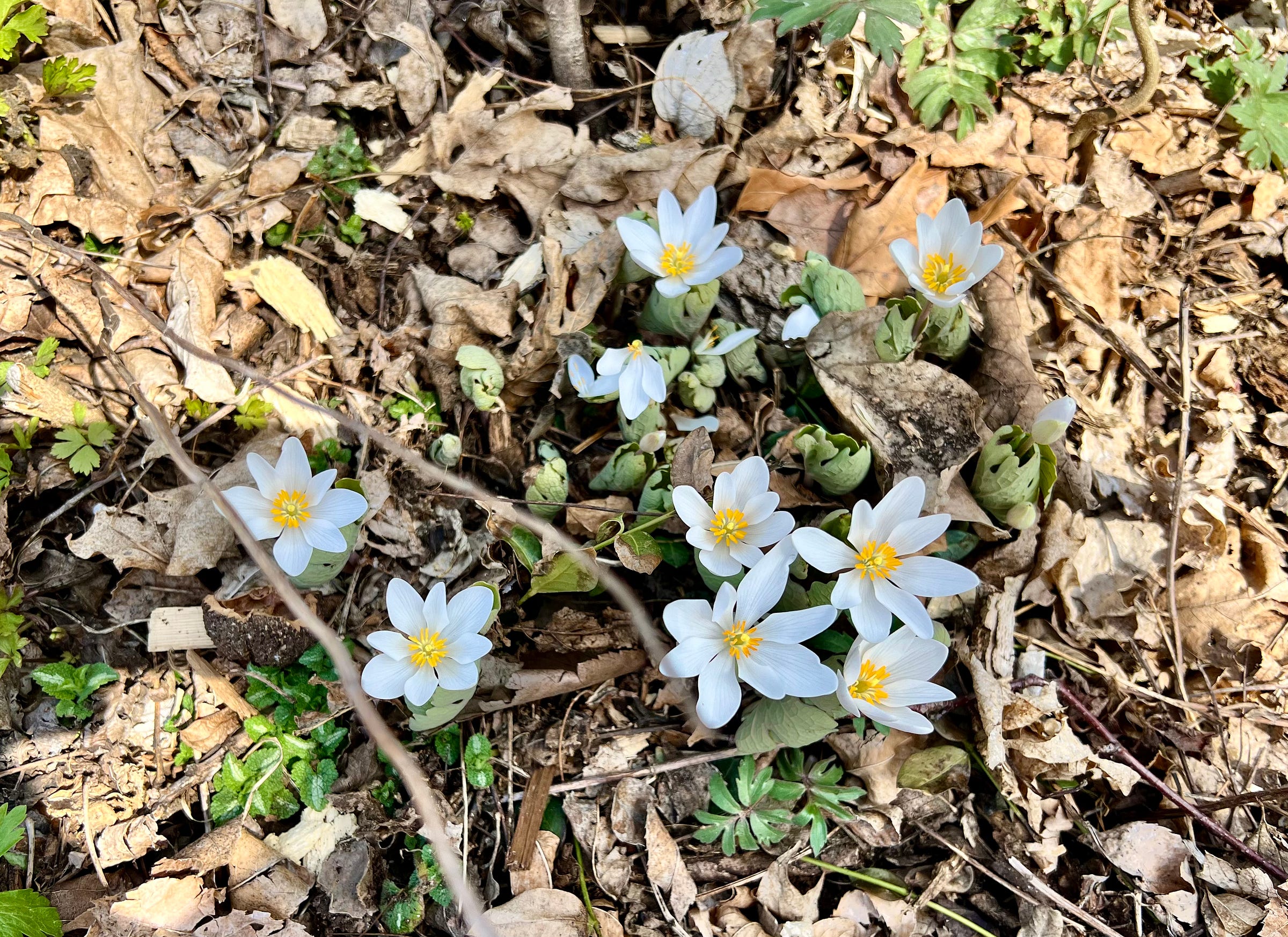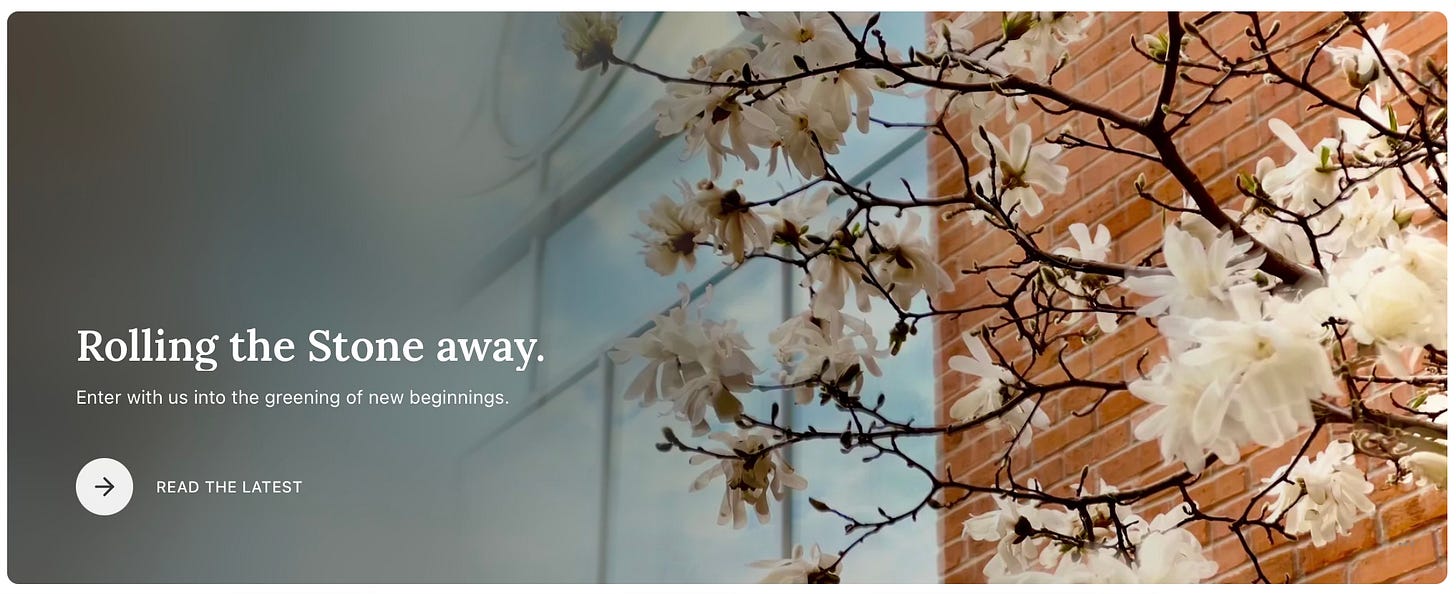Praising Spring's greening with Hildegard of Bingen
Your (mid)weekly blessing from the garden.
Friends,
Just in time for Easter, Spring has arrived in the Upper Midwest. Crocuses and early spring bloomers show up at unexpected places signalizing that Spring is here to stay.
Our laundry flutters on the line, officially bringing Spring to our back yard also.
“Viriditas,” the greening life force, as Hildegard of Bingen has it, is brimming, percolating in the trees, dripping into the containers hanging at the maple trees, and in each greening sprout unfolding.
I am not sure how Easter arrives in the southern hemisphere (Do tell us!). But here, where it corresponds with greening and flourishing after a long season of dormancy it lifts the guard rails from my heart — every morning I am walking into this vibrancy of new beginnings with my morning coffee.
And dear friends, Easter does not come to me easily.
I am not a Hallelujah singer.
I am a weary pilgrim, who has fallen so deep into the well of earnestness that the heavy-heartedness is always only an inch away.
And I know, that many of you tend towards a weary heart also, perhaps because you carry personal loss or the pain of this whole world. It feels like the world is rather spiraling towards the tomb than towards new beginnings, doesn’t it?
And still, creation reminds us, despite whatever people do, there is a regularity in the seasons — and fresh leaves arrive from bare branches as long as we let it.
There is a wisdom in creation offering us this display of new beginnings breaking through the old layers of the past. The whole creation is a liturgy, dear friend, and invites us into its life giving symphony.
Hildegard’s Dance with Creation
When HILDEGARD OF BINGEN spoke about viriditas she surely was inspired by the lush Rhineland she grew up in. But her term “viriditas” does not only mean the greening we can see in front of our eyes. It encompasses the sacred life force which gives all living being breath, life and flourishing. (I have written on Hildegard’s theology of viriditas and her eco-spirituality more thoroughly in this published paper.)
One way to celebrate that symphony is to become part of it, to find your tune and voice in it.
Hildegard’s theological writings are full of green allegories. She speaks about the greening Mary, the greening soul, even greening sciences. All of them take part in that Divine greening, which transcends our dryness and brings flourishing to all.
Isn’t that what Easter is about, dear friend. When new life springs from the desert, and the tomb becomes the womb?
Thus Hildegard calls us into “cosmic partnership”1 to participate in the greening and flourishing, to tend to creation and to care for it properly. She calls us to participate in that cosmic symphony, to come and to watch, to listen and to play in this grand symphony of creation.
Your soul is like the sap in the tree, Hildegard writes.
Can you even imagine? That pulsing sap dripping from the trees in Spring, full of live giving power? That sap which feeds the whole tree?
Our soul is just like that! Full of life giving nutrients, it wants to inhabit every inch of our body, wants to flow through us like a river to bring greening to it all. And just like the sap in the tree it waxes and wanes, dries up, goes dormant, only to come back to life again.
Thus dear friend, Spring is not only for romantics. Spring is the Divine invitation to connect again with the liturgy of the cosmos, with the pulsing soul in all of being, and thus with the soul pulsing in us.
Thus:
Gardening is a sacred task.
Gardening is not just a work for those who have enough leisure time, for Hildegard it is both a physical and spiritual practice. And it is no wonder that gardens have been part and parcel of the monastic life. They were places for nature and nurture, for work and for rejuvenation, to heal and to nourish body and soul.
And it gives my heart great joy that, finally, I can venture into the garden again, and find my way by tending and caring. And while I remove old leaves to welcome young sprouts of new life, something shifts inside of me also.
No book, no text, can do what the symphony of creation can do for us if we are willing to listen.
And so friends, this week I bent down to pick some young dandelions, which some people call a weed. We eat it. Together with the first sprouts of chives we sprinkled it over our first Spring omelet. It tasted like heaven indeed.
So our midweekly blessing comes to you today in the words of Saint Hildegard:
"Glance at the sun.
See the moon and the stars.
Gaze at the beauty of earth’s greenings.
Now, think.
What delight God gives to humankind
with all these things. . . .
All nature is at the disposal of humankind.
We are to work with it.
For without it we cannot survive."
— Hildegard of Bingen
May you find consolation and new strength in the great symphony of greening!
Yours, Almut (aka The Existential Pilgrim)
PS: If you can, leave a heart, a word or a line which resonated with you, a comment or a question in the comments, so we know you have been here :-)
Thank you for reading, sharing and supporting Cloister Notes, an independent letter for dancing monks and weary pilgrims to deepen your path and find wisdom with-in.
If you have been moved by what you are reading, do consider becoming a paid subscriber. Every paid subscription is a stepping stone towards making this labor of love my full time work. As a paid subscriber you have access to our live retreats and seasonal Contemplations.
You can share this letter by simply forwarding this email, by sharing it on your social networks, or if you are a substacker, by restacking it. Thank you.
Previous Posts
Upcoming Program
In person Spring Retreat With Hildegard of Bingen
May 9 @ 5:00 pm - May 11 @ 3:00 pm ($200)
On this Mother’s Day weekend (not only for birth mothers), we will ponder with Hildegard on Divine mothering and the greening of the soul, exploring its resonance across life’s seasons and how it nourishes our soul. We will read, reflect, journal and rest while joining the daily rhythm of the monastery.
Facilitator: Dr. Almut Furchert
Location: Saint Benedicts’s Monastery, MN
About Cloister Notes
A letter for dancing monks and weary pilgrims at the intersection of psychology, philosophy, and spirituality. Contemplations on being human to deepen your path, nourish your heart, and build wisdom within. A resting place along the way—a space for reflection, courage, and hope.
About The Weary Pilgrim
Almut is a German-American scholar and practitioner of existential wisdom teachings. A psychologist turned philosopher turned writer, she also walks as a traveler, photographer, retreat leader, and mother of a kindergartener. Her work engages with voices like Kierkegaard, Buber, Frankl, Yalom, Edith Stein, Bonhoeffer, and Hildegard of Bingen. A Benedictine Oblate, she lives with her family in a small college town in the American Midwest.
You can manage your subscription here.
https://digitalcommons.csbsju.edu/social_encounters/vol8/iss2/18/











https://music.youtube.com/watch?v=BNMKGYiJpvg&si=aUN48StQ8UlRY6Ds
Almut, when I read your inspirational offering today, Nina Simone’s, Feeling Good came to mind. Thought I should share.
So wonderful to read, and to consider greening in this context. Thank you!